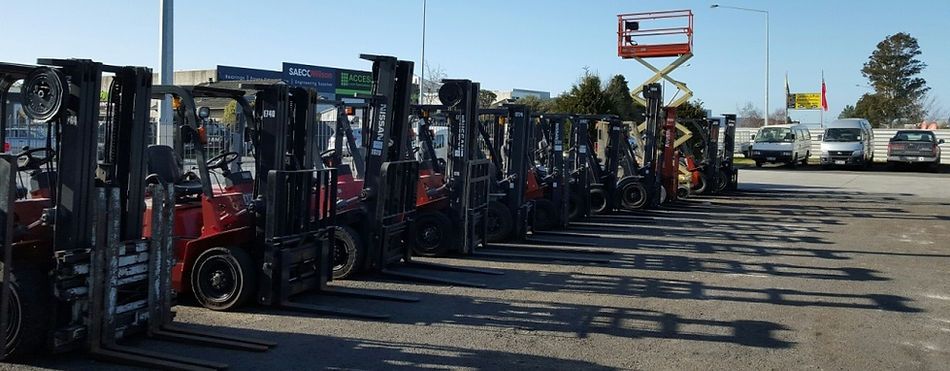

What to look for when buying a used forklift...
Some businesses do not need a new forklift, but have an occasional job where this type of equipment is necessary.
A used truck fits these sporadic transporting and lifting requirements quite well.
But how do you go about evaluating and picking a used forklift? The answer involves two considerations.
First, evaluate the lifting and moving tasks required. This step is the same as for a new truck, and includes lifting capacities, aisle dimensions, turning radiuses, lift heights required, mast height when lowered (for accessibility to all areas) and overall working environment.
Second, see what is available in the used forklift market. This factor involves numerous considerations.
-
Stay with a major manufacturer who has a good local dealer: Look for a popular size and model from a manufacturer with a proven track record and strong market position. A low-use truck will not be replaced for a long time, but will need occasional service. Make sure parts and local expertise are available.
-
Determine the preferred fuel: Petrol is a sturdy performer, but creates emissions that are a concern for indoor use. Some companies are trying to eliminate its use on the site for environmental and safety reasons. Insurance carriers may also have guidelines for fuel handling. Diesel fuel carries many of the same concerns. LPG is a better choice for indoor use, but exchange gas bottles or a refuelling station are required. Compressed natural gas is a more recent option, but the refuelling station is even more expensive.Electric forklifts are usually the best inside choice, but require a charger and charging station. A plant with a lot of ramps and/or high storage shelf heights may find electrics running out of power before the shift is overJob specifications and plant environmental concerns usually dictate the fuel choices to consider.
-
A high-visibility mast is nice, but not essential: This type of mast uses two small lift cylinders, one on each side, instead of one large cylinder in the middle. The high-visibility mast is standard on many newer models, but you may be paying a premium for a feature you do not need to perform the assigned tasks.
-
Model year is not nearly as important as condition: Most users get rid of their forklifts and put them on the used market when the vehicles reach their "economic service life." A truck removed from a high-use application may have many years of low-use life left. Check the maintenance record of the truck, or if not available, have the vehicle checked over by a qualified service technician.
-
Masts are available in one, two, or three stages: A three-stage is necessary only if you are reaching very high. One or two stages are probably enough, but take a three if you can get it without paying extra.
-
Consider the need for free lift, which is how much the forks go up before the mast starts extending: This feature is important for stacking or unstacking pallets inside a truck or sea freight container. More is better.
-
Check mast lift cylinders: Don't accept scored or scratched cylinders. They are expensive to repair. Check cylinders for leaks around the seals.
-
Base capacity requirement on the heaviest load anticipated: Capacity is often based on a load centred on the forks 600mm from the backrest, but the dimension could vary for different sized lift trucks. Vehicles should be rated at the same load centre to determine comparable capacity information.
-
Check vehicle length and turning radius carefully: A family of trucks with various capacities is often built on the same frame size, with the difference being the amount of counterweight or an extra inch or so of length. This little bit of extra length could transfer into a larger turning radius that cannot negotiate through the warehouse or factory aisles.
-
Check the tyres: Cushion tyres are solid rubber, good for smooth surfaces indoors, and do not go flat. Pneumatic tyres are better for outside and rough surfaces.
-
Make sure the truck includes all relative safety equipment: The vehicle should include an overhead guard, load backrest, safety light, fire extinguisher, working horn and parking brake.
-
Check the engine: Some engine wear is expected, but don't take too much. Does it run rough? Does it produce white or black smoke? Does it make "spitting" noises out of the exhaust? Does the engine make questionable noises, such as a dull thud or sharp whack? Consider a compression check. Remove the spark plug, hold the throttle wide open, and crank the engine a few times while a compression gauge is held in each spark plug hole. The reading from the lowest cylinder should be within 80% of the highest. Examine the spark plugs while they are out. Unless new, they should be a light-to-medium tan. Black and sooty is an indication of a problem.
-
Check the brakes: The pedal should be firm, not spongy. Look behind each wheel for signs of brake fluid leakage. The truck shouldn't pull when the brakes are applied, or make squealing or scraping noises when stopping.
-
Check the transmission: Drive the lift truck up an incline. There should be no signs of slippage.
-
Check "inching" capability: The truck should be able to creep forward, backward, and lift up or down gently, carefully, and in small increments. Controls should have an easy touch; not jerky or with sudden large movements.
-
Side shift is nice, but not always essential: Side shifters add cost, and slightly derate the lifting capacity. Does your application require this function?
-
Is the lift truck neat and clean? First impressions are important. Has the truck been repainted and serviced?
Remember to buy the truck you need. A bargain that doesn't meet your specifications is not a bargain, but a waste of money.


